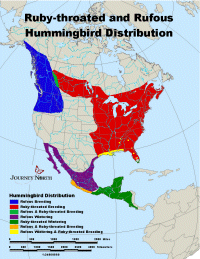Hummingbird
Migration Update: May 4, 2006
Today's Report Includes:
- Latest Migration News: The Home Stretch
- Thanks!
- Fifteen Seconds With a Male Hummingbird: What Do You See?
- How Brainy Are Hummers?
- Hmmm. Would You Rather be a Male or a Female?
- Rufous Hummers in High Latitudes: Discussion of CQ #7
- Feeding Your Hummers
- Year-End Evaluation: Please Share Your Thoughts!
Hummingbird Maps and Data
 Distribution Map |
||
| Rufous
|
Ruby-throated
Most
data courtesy of Lanny Chambers, |
Latest
Migration News: The Home Stretch
Wow! Ruby-throated hummingbirds-those pennyweight powerhouses-continue
surging north. They're all the way to Nova Scotia! Amazingly, many of you report
your
hummers arriving on the same date each year. “The two arrived this morning
just as they have for the past three years on May 1!”
In the West, Rufous hummingbirds keep trickling eastward into the mountains
and beyond, but they appear to be at their northernmost limits. They continue
moving inland, away from the milder temperatures of the coast. “FINALLY
some Rufous hummingbirds," reported an observer in Douglas, Alaska. From Plains,
Montana comes this happy news: “Just a few minutes ago I had my first
gloriously colored male Rufous hummer at my feeder here in the high country.”
 |
Rufous
hummingbird female
Photo Laura Erickson |
Thanks!
Everyone is thrilled to welcome back these long-distance migrants.
Thank you for sharing your excitement and sightings with us for
the 2006 migrations! With this final full report (next time is
data and maps only), we'd like to send a big THANKS to Lanny
Chambers for sharing his Rubythroat hummingbird maps and data
once again this spring, and to Mike Patterson for his Rufous
data contributions.
Fifteen Seconds With a Male Hummingbird: What Do You See?
This week, watch a male hummingbird during his brief, 15-second visit to a feeder. Can you see him fly forward, backwards, sideways, and hover? What else do you see and wonder? Then compare the male with the female clip to see how they are similar and how they are different. Finally, enjoy a few slow motion clips of the hummingbird's beak, tongue, and flight--and listen to its humming wings.
- Fifteen Seconds With a Male Hummingbird
- One Minute With a Female Hummingbird
- Hummingbirds: Close-up and in Slow-motion
|
|
||
 |
 |
How Brainy Are Hummers?
Everywhere they appear, these tiny winged wonders are flocking to feeders and flowers. Do you ever wonder if they can tell the flowers that still have nectar from the ones they've already emptied? How long does it take for a flower to replenish its nectar after a hummingbird or other pollinator visits it? Scientists doing research have discovered that Ruous hummingbirds are brainy. Pretend you're a hummingbird in search of nectar as you play our simple memory activity.
- Can Hummingbirds Tell Time? Scientists Discover that Hummers
are Brainy
Why were thee wild male rufous hummingbirds fed from artificial flowers? What could scientists hope to learn from such an experiment? Find out here!
Photos: Andrew Hurly
Hmmm. Would You Rather be a Male or a Female?
 |
Photo Dorothy Edgington |
Then try assigning hummingbird jobs, using this chart:
Rufous Hummers in High Latitudes: Discussion of CQ #7
We asked: “At what town and latitude was this week's northernmost sighting report? Do you predict Rufous hummingbirds will be seen any farther north than this week's northernmost sighting? Defend your answer. What changes-northward or eastward-- do you predict the migration will show in one week?”
A data check from the April 20 Update shows the northernmost latitude sighting at 58.85 -134.68 in Auke Bay, Alaska. On April 27, it was 58.48 -134.16 in Juneau, Alaska, and it's another Juneau sighting in today's data. Could Rufous be at their northern limits? That's what the data suggest. But some of them are still on the move. Keep checking our map server to see what happens next!
 |
Rufous
hummingbird male
Photo Carl Pascoe |
Feeding Your Hummers
In his answers for Ask the Expert, Mr. Chambers reminded us to keep hummingbird feeders clean and food fresh. The best recipe is one part cane sugar (rather than beet sugar) to four parts water. Your hummingbirds each eat 1.5 times their body weight each day! (How much food would YOU need to eat daily if you were a hummingbird?)
Be sure your sightings are on the map as we complete the 2006 migration story! To Report >>>.
| Year-End Evaluation: Please Share Your Thoughts! | |
| Please take a few minutes to share your suggestions and comments in our Year-End Evaluation. The information you provide is critical for planning new initiatives and for improving Journey North. Also, as a free program supported by a generous grant from Annenberg Media, we want to be able to document Journey North's reach, impact and value. THANK YOU! | |

|
Journey
North |
The FINAL Hummingbird Migration Update Will Be Posted on May *11, 2006 (Migration Maps and Data only).
Copyright
1997- 2006 Journey North. All Rights Reserved.
Please send all questions, comments, and suggestions to our
feedback form.
![]()
![]()
![]()
![]()
![]()
![]()












